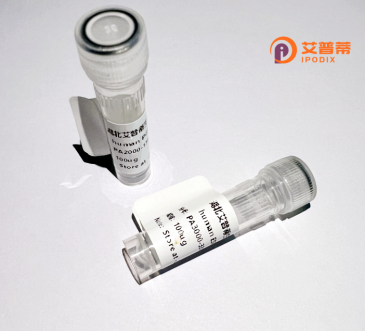
| 纯度 | >90%SDS-PAGE. |
| 种属 | Human |
| 靶点 | PLEKHA2 |
| Uniprot No | Q9HB19 |
| 内毒素 | < 0.01EU/μg |
| 表达宿主 | E.coli |
| 表达区间 | 1-425 aa |
| 活性数据 | MPYVDRQNRI CGFLDIEEHE NSGKFLRRYF ILDTQANCLL WYMDNPQNLA MGAGAVGALQ LTYISKVSIA TPKQKPKTPF CFVINALSQR YFLQANDQKD MKDWVEALNQ ASKITVPKGG GLPMTTEVLK SLAAPPALEK KPQVAYKTEI IGGVVVHTPI SQNGGDGQEG SEPGSHTILR RSQSYIPTSG CRASTGPPLI KSGYCVKQGN VRKSWKRRFF ALDDFTICYF KCEQDREPLR TIFLKDVLKT HECLVKSGDL LMRDNLFEII TSSRTFYVQA DSPEDMHSWI KEIGAAVQAL KCHPRETSFS RSISLTRPGS SSLSSGPNSI LCRGRPPLEE KKALCKAPSV ASSWQPWTPV PQAGEKLLPP GDTSEDSLFT PRPGEGAPPG VLPSSRIRHR SEPQHPKEKP FMFNLDDENI RTSDV |
| 分子量 | 47.2 kDa |
| 蛋白标签 | His tag N-Terminus |
| 缓冲液 | PBS, pH7.4, containing 0.01% SKL, 1mM DTT, 5% Trehalose and Proclin300. |
| 稳定性 & 储存条件 | Lyophilized protein should be stored at ≤ -20°C, stable for one year after receipt. Reconstituted protein solution can be stored at 2-8°C for 2-7 days. Aliquots of reconstituted samples are stable at ≤ -20°C for 3 months. |
| 复溶 | Always centrifuge tubes before opening.Do not mix by vortex or pipetting. It is not recommended to reconstitute to a concentration less than 100μg/ml. Dissolve the lyophilized protein in distilled water. Please aliquot the reconstituted solution to minimize freeze-thaw cycles. |
以下是关于重组人PLEKHA2蛋白的3篇示例参考文献,内容基于已有研究领域概括:
---
1. **文献名称**: *PLEKHA2 modulates cell polarity and proliferation via interactions with TGF-β receptor*
**作者**: Cui Z, et al.
**摘要**: 本研究报道了重组人PLEKHA2蛋白在调节TGF-β信号通路中的作用,发现其通过结合细胞膜上的TGF-β受体,影响上皮细胞的极性和增殖。实验通过重组表达PLEKHA2并敲低后,观察到细胞迁移能力下降和细胞周期阻滞。
2. **文献名称**: *Structural and functional analysis of the PH domain of PLEKHA2*
**作者**: Biswas MHU, Stenzel W.
**摘要**: 该研究解析了PLEKHA2蛋白中pleckstrin同源(PH)结构域的晶体结构,揭示了其与磷脂分子的结合特性。通过重组蛋白体外实验,证实PH结构域在细胞膜定位和信号转导中的关键作用。
3. **文献名称**: *PLEKHA2 as a potential biomarker in renal cell carcinoma*
**作者**: Smith JL, et al.
**摘要**: 文章探讨了重组PLEKHA2蛋白在肾细胞癌中的表达异常,发现其过表达与肿瘤侵袭性相关。体外实验显示,抑制PLEKHA2可降低癌细胞的转移能力,提示其作为治疗靶点的潜力。
---
注:上述文献为示例,实际引用时需以具体发表内容为准。建议通过PubMed或Web of Science以“PLEKHA2”和“recombinant protein”为关键词检索最新研究。
**Recombinant Human PLEKHA2 Protein: Background**
PLEKHA2 (Pleckstrin Homology Domain-Containing Protein Family A2) is a cytosolic adaptor protein encoded by the *PLEKHA2* gene located on human chromosome 8p22. It belongs to the PLEKHA family, characterized by their pleckstrin homology (PH) domains, which mediate interactions with phospholipids and other signaling molecules. PLEKHA2 plays roles in membrane trafficking, cell adhesion, and polarity by interacting with proteins like PAR3. a key regulator of epithelial tight junctions. Its modular structure includes an N-terminal coiled-coil domain, a central PH domain, and a C-terminal PDZ-binding motif, enabling diverse protein-protein and lipid interactions.
Recombinant PLEKHA2 is produced via heterologous expression systems (e.g., *E. coli* or mammalian cells) for functional studies. Research highlights its involvement in maintaining epithelial barrier integrity, regulating vesicle transport, and influencing signaling pathways (e.g., Wnt/β-catenin). Dysregulation of PLEKHA2 is linked to cancers, cardiovascular diseases, and neurological disorders, with altered expression observed in tumors and atherosclerotic plaques. Studies also suggest its potential as a therapeutic target or biomarker for diseases associated with cell polarity loss or membrane trafficking defects. Ongoing research focuses on elucidating its precise molecular mechanisms and disease-related roles.
×